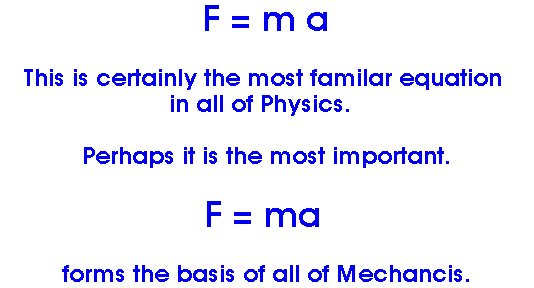

Newton's Second Law,
F = ma In the presence of a NET FORCE, an object experiences an ACCELERATION
- directly proportional to the NET FORCE
- inversely proportional to the MASS of the object.
Remember, though,
- F is the NET force
- m is the mass which that net force acts on.
We often turn this around and write it as

What are the UNITS of force in
F = m a A force of ONE unit will give an object of 1.0 kg mass
an acceleration of 1.0 m/s/s ;
this force is known as
ONE NEWTON (1.0 N) .
1 N = ( 1 kg ) ( 1 m/s/s )
F = m a Force will be measured in newtons A force of 1 N will give
a mass of 1 kg
an accelertion of 1 m/s/s.
1 N = ( 1 kg ) ( 1 m/s/s )
12 N = ( 3 kg ) ( 4 m/s/s ) A force of 12 N could give a mass of 3 kg
an accelertion of 4 m/s/s
12 N = ( 2 kg ) ( 6 m/s/s ) A force of 12 N could give a mass of 2 kg
an accelertion of 6 m/s/s .
If an object is in equilibrium--at rest--then, the net force on the object must be zero.That is, the sum of all the forces on an object is zero when the object is in equilibrium.
Mass Weight Return to ToC, Ch4, Newton's Laws of Motion (c) 2002, Doug Davis; all rights reserved